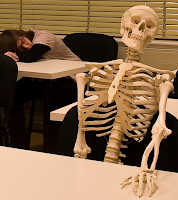Memory is a strange thing.
The other day, I decided to visit my 87-year-old mother earlier than usual—we get together every Sunday—because her assisted-living facility was having a vintage car show with live music and food, and I wanted to get a parking space. They fill up quickly when there's a family event.
I knocked on her apartment door and she answered, surprised to see me at 11:30 a.m. instead of our usual after-lunch meeting time. I reminded her that there was a car show downstairs. I came early so I didn't have to park way down the road from her facility.
"Oh!" she said. "Well that makes sense. But I have to go down to the dining room for lunch before we attend the party."
"Okay," I replied. "I'll wait here until you're finished, then we can attend the party together." She agreed and left for the downstairs dining room.
I sat on her bed and played card games on my iPhone and lost track of the time. I suddenly realized that more than an hour had gone by. The music outside was so loud that it filtered into the room. I decided to go downstairs to see what had become of my mother.
When I walked outside, I saw her dancing in the street with her geriatric friends. I watched for a while and realized that the dining room was probably closed and she had gone outside, eaten picnic food and forgotten I was in her apartment. After the music stopped, I walked over to her and asked if she remembered I was waiting upstairs.
"Oh!" she said, "I forgot about that!" So we walked around looking at all the old cars and I took her picture next to a few of them. The band started up again, but Mom opted to sit in the shade with me until the Big Show. Just as she used to come see me in school productions when I was growing up, I now see her in assisted-living productions.
As 2 p.m. rolled around, the activities director called her bell choir together and my mom took her seat in two rows of chairs that had been set up for them. The bell choir rocked to songs like "Good Old Summertime" and there was also a number where they all played the kazoo. Everyone was snapping pictures and the choir clearly enjoyed being the center of attention.
I found myself quietly chuckling. Whatever possessed me to wait in her room for an hour when they were serving picnic food outside? I had passed the outdoor grills as I walked inside. Was she the one with the bad memory or was it me?
The other day, I decided to visit my 87-year-old mother earlier than usual—we get together every Sunday—because her assisted-living facility was having a vintage car show with live music and food, and I wanted to get a parking space. They fill up quickly when there's a family event.
 | |
| Mom poses by a vintage car. |
I knocked on her apartment door and she answered, surprised to see me at 11:30 a.m. instead of our usual after-lunch meeting time. I reminded her that there was a car show downstairs. I came early so I didn't have to park way down the road from her facility.
"Oh!" she said. "Well that makes sense. But I have to go down to the dining room for lunch before we attend the party."
"Okay," I replied. "I'll wait here until you're finished, then we can attend the party together." She agreed and left for the downstairs dining room.
I sat on her bed and played card games on my iPhone and lost track of the time. I suddenly realized that more than an hour had gone by. The music outside was so loud that it filtered into the room. I decided to go downstairs to see what had become of my mother.
When I walked outside, I saw her dancing in the street with her geriatric friends. I watched for a while and realized that the dining room was probably closed and she had gone outside, eaten picnic food and forgotten I was in her apartment. After the music stopped, I walked over to her and asked if she remembered I was waiting upstairs.
 |
| The bell choir in action. Mom is in the middle. |
"Oh!" she said, "I forgot about that!" So we walked around looking at all the old cars and I took her picture next to a few of them. The band started up again, but Mom opted to sit in the shade with me until the Big Show. Just as she used to come see me in school productions when I was growing up, I now see her in assisted-living productions.
As 2 p.m. rolled around, the activities director called her bell choir together and my mom took her seat in two rows of chairs that had been set up for them. The bell choir rocked to songs like "Good Old Summertime" and there was also a number where they all played the kazoo. Everyone was snapping pictures and the choir clearly enjoyed being the center of attention.
I found myself quietly chuckling. Whatever possessed me to wait in her room for an hour when they were serving picnic food outside? I had passed the outdoor grills as I walked inside. Was she the one with the bad memory or was it me?


















